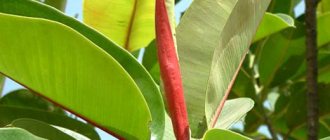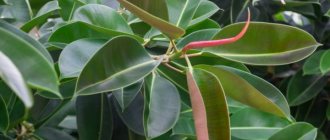Beneficial features
In addition to the fact that rubber is extracted from this plant, ficus is also considered the most useful flower, which can significantly improve the health of the air. This happens because air passes through the leaves like through a pipe. During this passage, it is significantly enriched with oxygen.
Another important advantage is the ficus’s ease of care.
When grown at home, it practically does not bloom, is not capricious and can adapt to absolutely any conditions. The only thing is that the plant needs to be kept away from direct sunlight, watered and bathed on time and in the right amount.
How to properly pinch at home?
In order for the procedure to be successful, the owner of the ficus needs to know the following:
- It is important to choose the right time for pinching. Otherwise, the plant can easily die.
- Ficus juice is poisonous and can cause burns or allergic reactions. Therefore, all manipulations with the plant must be carried out with gloves.
- It is better not to combine pruning with another procedure, for example, replanting.
Ficus can be easily pinched at home if you follow the established rules.
Timing for the procedure
Experienced gardeners know that the ideal time to pinch out ficus is spring. It is during this period that the plant becomes active, forming new shoots and buds. Therefore, the procedure will not be too stressful for the flower, and all “wounds” will heal quickly.
Important! Pinching in autumn or winter can lead to the death of the ficus.
Pinching Instructions
Before you start forming the crown, you need to decide on the choice of knife. It should be sharp enough to cut thick branches straight away. The knife must be disinfected with alcohol or peroxide. If the plant is young, then unnecessary shoots can simply be cut off.
But if the ficus is already several years old, then you need:
- determine the point that will become the top;
- the cut should be made at a distance of 6–8 cm from the sheet;
- branches should be cut obliquely;
When pinching, it is necessary to rinse all cut areas with water. Since the sap of the plant will slow down the growth of new shoots. To form an ideal crown, pinching and pruning should be done annually.
Important Rules
The procedure for forming a crown largely depends on what the gardener wants to achieve. For example, to obtain the shape of a standard tree you need:
- Choose a young, unformed ficus without lignification.
- Then gradually remove the side shoots until 5 top branches remain.
- When the ficus reaches the required height, the top shoot should be pinched and the side shoots removed.
- For young stems without bark, you need to build a support. It will be needed until the ficus finally grows.
Such a standard can be multi-tiered. To do this, the crown is divided into 4–5 parts. The odd ones will be the crown tiers, and the rest will be the spaces between them. To form the latter, shoots are cut 5–7 cm shorter than in tiers.
In addition to the standard, there are several other ways to design a beautiful crown. This is a bush and an arc. To form the first type, it is important to ensure that the ficus does not grow upward, but produces lateral shoots. This is controlled by pinching the flower annually.
The arch is created very simply - the upper part of the plant is bent and fixed at the required height. The upper buds begin to produce new shoots, making the plant more voluminous. As soon as the side shoots reach the desired length, the fixation is removed. The branches of the ficus will remain in the same position, forming an interesting arc.
Further care
After the stress suffered due to the procedure, the ficus needs additional feeding. It is added immediately or wait 1-2 weeks until the plant adapts. If necessary, you can transplant the ficus into a new pot. This is true for plants that no longer fit in the old container.
Is it possible or necessary to prune ficus?
Many newcomers to gardening or people who have not previously dealt with such procedures are interested in simple but quite logical questions, for example, is it possible to prune ficus benjamina? Many people really believe that it is impossible, complaining that the plant then dies. Such a course of events is not excluded, but it becomes relevant only when the pruning was carried out incorrectly, sloppily, or roughly. If everything is done carefully, then it will not in any way affect the further growth of the ficus, which, moreover, will even be happy with the modifications that are so necessary for it.
Thus, the myth about the harmfulness of pruning for a plant has been successfully destroyed, what about the immediate formation of the crown? Experienced gardeners believe that the best time of year for this business is spring, and they are largely right. It is at this time that the ficus is most prone to growth, the corresponding processes take place in it, and the microclimate, specifically for it, in the time period from March to April is very favorable. It would be a small mistake to form the crown later, but it is likely that it will turn out somewhat skewed, possibly asymmetrical.
This is if we talk about aesthetic nuances, but there are more important factors that directly affect the health of the ficus, which accumulates nutrients over time. To carry out pruning during this period means to deprive the plant of food, and therefore lead to its disease or, even worse, to death.
Care after pruning
There are a number of rules that must be followed in order for the flower formation process to be successful:
- When cutting, stumps should not be left, as they become hotbeds for the development of fungal and bacterial diseases.
- After pruning, a milky sap begins to ooze from the plant, which must be immediately wiped off and the cut area sprinkled with crushed charcoal or any fungicide.
- You can fertilize the ficus after pruning once a month.
Ficus pruning process
- In addition, after pruning, it is necessary to regularly wipe the leaves from dust in order to reduce the risk of infection of the plant.
- A month after the procedure, when the cut sites have completely healed and the side parts begin to actively grow, the flower can be replanted, and the top layer of the substrate can be changed for mature plants. Experts recommend using the transshipment method in order to minimize the risk of injury to the root system during transplantation.
How to pin a ficus
Ficus is a magnificent representative of the tropical flora, which recently settled in our apartments. The ornamental tree grows quite rapidly (up to 30m in height) and requires proper pinching. Otherwise, the top of the ficus will quickly reach the ceiling level, and the plant will become unsuitable for growing indoors.
If the calendar says autumn or winter, postpone the process to a more appropriate time. It is much better to pinch the ficus in the spring. Between March and June, shoots form faster and wounds heal better.
First, prepare the necessary tools and materials: a sharp knife, a disinfectant solution, a soft cloth and a container of water. Next, wipe the knife or pruning shears with the solution and heat it over the burner. This will kill the bacteria.
If the tree is not tall, make a straight cut from the top shoot just below the level of the growing point. In case the height is too high, you need to proceed as follows: determine the priority height and find a leaf or branch a little lower. Start from it. Make an oblique cut, the bottom of which will be on the opposite side of the bud, and the top above it.
Moisten a soft cloth with warm boiled water and wipe off any milky juice that appears. It is better to do this work with gloves, since ficus sap is quite poisonous. The used rag should be thrown away. Keep in mind that the trunk of a trimmed ficus tree will not grow back. Be careful when choosing height.
After a month, feed your plant. After this, new shoots will grow more actively. If desired, you can transplant the tree into a larger container. But such measures are not at all necessary.
If you intend to form a thick, lush crown, repeat the same procedure next year. Use side branches to continue pinching.
Please note: timely and correct pinching of the ficus will not only allow you to maintain the permissible height (within the limits of the ceiling), but also create an unrivaled, curly crown. Don't be lazy - get started!
- How to trim a ficus
- How to root ficus benjamina
- How to care for ficus
When pruning, ficus milky sap is released abundantly, so immediately spray the cut area with water to stop its release.
For plants that produce little sap when pruned, sprinkle the cut area.
Because You are not logged in. To come in.
Because The topic is archived.
Creating unusual shapes
Standard tree
The trunk is created by freeing the trunk from young leaves and twigs to the required height. At the same time, the top is also shortened, and a spherical crown is created around the stem, the correct shape of which must be constantly maintained by removing shoots and pinching leaves in the upper internodes.
Fence
After the mature rubber ficus has been pruned, you can start creating an interesting display in the form of a hedge or fence. Shoots that have been cut off are suitable for this. They are rooted in a shallow but fairly spacious box in one row. As they grow, you can attract the trunks to each other, cutting off the bark at the point of contact and tightly fixing the “wounds” together with film and wire. The more light there is in the room, the faster the branches will grow together at the points of contact and you can start a new row.
Spiral
To obtain a spiral shape, the tree is tied to a strong base (post or stick) and gradually twisting the trunk, securing it with wire or cord. Side branches and leaves should be removed to expose the beautiful, spiral-shaped stem.
Scythe
A very popular type of ficus formation. To do this, 3 young sprouts are planted in a box, and as they develop, the trunks are intertwined in the form of a pigtail, fixing them at the point of contact with polyethylene and wire. At the place of fixation, the bark is removed with a sharp knife, and the milky juice that appears in the “wound” is wiped with a cloth. It is most convenient to start weaving when the plant reaches 15-18 cm in height. The next fixation is carried out as the trunk lengthens, and the lower leaves and shoots are removed.
Pruning is not always necessary to create a neat crown. Ficus provides ample opportunities for flower growers to express their imagination. By following the rules for caring for it, you can create interesting compositions, decorate it in the form of a tree or achieve increased bushiness, thereby decorating the space with an original indoor flower. At the same time, you will not injure the plant, for which cutting is always a powerful stress.
Rules for the formation and selection of inventory
For trimming you need to use tools that are convenient and familiar. The main thing is that they are sharp and clean. You can take:
- pruner;
- scalpel;
- garden knife.
To form a ficus you may need:
- garter - ropes, wire, pieces of fabric;
- removal of latex - gauze or cotton swabs, clean rags, napkins;
- treatment of wound surfaces - garden pitch, crushed activated charcoal or charcoal;
- support – pipe covered with coconut fiber;
- stimulator – cytokinin paste;
- to protect hands - gloves.
Pruning and shaping the crown requires following some rules:
- Do not thicken the ficus too much. Leaves should grow freely without interfering with each other.
- Branches should be cut at a right angle, 1-2 cm above the leaf. If the crown is going to be used for propagation, and the internode is too long, the lower part of the cutting is cut off additionally.
- Forming or pruning a weakened, diseased plant cannot be carried out.
- When transplanting, the trunk of the rubber-bearing ficus can be slightly deepened. Sometimes this is enough to increase the stability and decorativeness of the tree.
- With a high probability, after pruning, a side shoot will appear from the nearest upper bud. This way you can control the direction of growth of the ficus.
- It is often advised to remove the milky juice after shaping or trimming and not treat the wound surface with anything, but this is wrong - there is a risk of infection. In addition, activated carbon or garden pitch stops the leakage of latex, and Elastica consists of 15% of it. The top of the trunk will become dry, and the nearest bud and leaf may disappear. This is clearly visible in the photos and videos presented by flower growers who took 1-2 minutes to treat the wound surface.
- Sometimes when pruning and shaping the rubber ficus, it is advised not to leave stumps. But some of the soft wood will still dry out, and if there is not a piece of the stem at least 1-2 cm above the leaf, it will definitely grab the nearest bud with a plate. You'll have to repeat the trimming. It is better to let the process take its course, and then, without affecting living tissue, carefully remove the dried area, leaving 1-2 mm.
- It is recommended to work with gloves so that the rubber sap does not cause irritation when pruning.
- Ficus formation is carried out simultaneously or after the start of feeding. The plant will need additional nutrients to support the growth and development of new branches.
- The transplant is done a few weeks after pruning or shaping. Carrying out simultaneous operations is a lot of stress and greatly depletes the ficus.
How to grow ficus benjamina correctly?
Lush branches of the plant begin to form after the top shoot is removed. Ficus benjamina should be pinched when the plant is healthy and full of vigor. It is better to form a crown before reaching the age of three, while it is actively growing. After this time, it is more difficult to give the desired shape, and the restoration process will become a little more complicated. How to pinch ficus benjamina? To do this you need:
- Prepare the plant for the procedure - wash it in the shower and water it.
- Stock up on the necessary tools, water, a clean rag and activated carbon.
- It is recommended to cut thin branches straight, thick branches - obliquely.
- After trimming, the white juice is removed with a wet cloth and the cut is sprinkled with activated carbon.
- When pruning, keep an eye on the shape of the plant so that it has a pleasant, natural appearance.
- Branches that spoil the appearance, grow parallel to the main trunk, intertwine and greatly thicken the ficus must be removed.
- The top and side shoots are shortened to give them the pre-planned shape.
Regular pruning is one of the components of ficus care and is necessary not only for the beauty, but also for the health of the tree.
How to form a beautiful crown of ficus benjamina
A neat ficus benjamina, without bare, elongated or sticking out “in the wrong direction” branches already looks attractive. All it takes is regular pruning. Proper crowning will bring the plant to perfection.
It is very important that the ficus is evenly illuminated from all sides; for example, you can turn it 20° once every 10 days. Otherwise, the crown will stretch in one direction.
Types of crown formation
At the very beginning of growing a ficus, you should decide what the owners want it to be like. The most common forms:
- Bush. It works best on small-leaved, low-growing varieties of ficus, especially Benjamin. If desired, you can decorate a tall plant this way.
- Standard A tree with the lower part of the stem exposed.
- Topiary - topiary, garden sculpture. As special cases, this includes balls and tiered trunks.
- Ficus bonsai is an art that even very experienced gardeners cannot always master. The plant is grown in the form of a small, intricately curved tree, sometimes completely different from its original shape. The effect is achieved by cutting not only branches, but also roots, and planting in a flat, low pot. When creating bonsai, special devices are used - wire, ropes, spacers, etc.
The simplest methods of formation
Beginning flower growers are able to independently form Ficus Benjamin in the form of a lush bush or standard tree. You should start working on more complex topiary or bonsai after gaining experience in pruning and shaping.
Bush
You can plant several cuttings in one pot and immediately get a lush bush. Shaping and pruning will come down to sanitary measures, removing or shortening inward growing, overly elongated, “out of order” branches.
It is more difficult to create a bush from a single plant. To get a hairy ficus, first of all you need to remove the top of the main trunk - cut it off as soon as the cutting reaches 15 cm, leaving 5 leaves. This will give impetus to the growth of side shoots.
When they stretch to 10-15 cm, shorten them by a third so that the bud above the cut faces outward. Subsequently, the shoots directed into the bush are thinned out and pinched.
Standard tree
It is important that the trunk is not thin. Therefore, the lower skeletal branches of a ficus intended for growing in the form of a tree are not touched for a long time. Then they are cut into a ring.
First, a frame is formed, after which they begin to build up the crown. Unnecessary branches are cut out, the rest are shortened to a length of 1/3 to 2/3.
When the top becomes sufficiently lush, the formation will be as follows:
- removal of shoots on the trunk;
- spring pruning of too long, thickening, unnecessary branches;
- pinching the tops.
Topiary forms
The simplest topiary is a crown in the shape of a ball or oval on a trunk. The main pruning is carried out in the spring; pinching is done throughout the season.
It is a little more difficult to create a tiered trunk from several cuttings of different ages:
- Young ficus are planted.
- Cut to get a standard.
- When the tree reaches a certain size, another cutting is placed closely. The trunks are tied in several places - after a while they will grow together.
- Formation is carried out by pruning the crown of the second ficus.
It is not necessary that topiary should look like balls strung on a stick. The crowns of the lower cuttings can be shaped so that they are directed away from the trunk.
Of course, it is possible to divide the tree into parts, alternately exposing the trunk or leaving branches to get several tiers. But ficuses, even those belonging to the Benjamin species, are not plants with which this can be easily done with pruning.
Firstly, it will take years to create a beautiful crown, and not 3-4, but much more. It will be difficult to support her. And secondly, such a tree is still inferior in decorativeness to one created from 2-3 cuttings.
Timing for the procedure
How to make a ficus branch and how complex is such a set of measures? The result will certainly satisfy you if you not only study the necessary principles of the procedure, but also determine what time of year it is best to carry it out. It is possible to get a branched crown from a ficus, but it is better to start pruning in the spring. With the onset of spring, the plant wakes up and all vital processes are activated. If you start pinching the flower at this favorable time, the pruning procedure will not be too stressful for the plant: all the “wounds” will heal instantly. In addition, it is in the spring that young buds form on the plant stem and side shoots develop.
That is why there is no more suitable time for the formation of a ficus crown than the spring period, or rather the end of winter - the beginning of spring. Remember, it is unforgivable to delay with this procedure. If you start pruning your home ficus in mid-spring, the result may not be of very good quality. The thing is that when sap flow is active, shortening the branches can awaken the flower and stimulate its growth as a whole, but the new side shoots will be too thin.
Ficus rubbery, how to form. Rules for pruning
Pruning is carried out in early spring, before the plant enters a period of active growth. The optimal time period for pruning ficus begins with the spring equinox, when daylight hours begin to gradually lengthen: after pruning, the ficus begins to grow, its axillary buds awaken, which produce lateral shoots. However, it is impossible to carry out both pruning and replanting of the ficus in the same time period: at least two weeks must pass from the day of pruning to the day of replanting (or vice versa).
Rules for pruning
The peculiarity of the rubber-bearing ficus is that it will grow upward until it hits the ceiling: under natural conditions, this plant can reach a height of 50 m. However, the first pruning of this species is carried out no earlier than it reaches 70 cm. If you think that the ficus has reached the desired height, cut off its growth point - the top of the main shoot. And to shorten a quickly grown plant, cut it at the desired height, but so that the cut goes a few centimeters above the leaf. Blot the wound with a wet cloth to stop the flow of milky juice. After a while, side shoots will appear on the ficus. If necessary, they are pinched to create a tree with a lush crown.
You need to pinch the plant not with your bare hands, but with a sharpened sterile instrument. Disinfect instruments with medical alcohol.
The top of the trunk is cut off obliquely, and the side shoots are separated with straight cuts. Thin branches can be trimmed with scissors, which are also pre-wiped with medical alcohol.
If you need to direct the growth of shoots in a different direction, do it with a wire: young ficus branches easily change direction.
Features of the plant
Ficus rubber (how to form a crown will be described in this article) is a plant that belongs to the genus Ficus of the Mulberry family. The homeland of this representative is considered to be India, namely its northeastern part, as well as southern Indonesia and western Africa. As an ornamental plant, it is grown outside tropical areas. In addition to the decorative function, it can also perform an industrial function, since it is large trees that produce rubber.
When growing in its natural conditions, ficus can reach a size of 40 m in height, while forming so-called support roots. The main feature of the latter is that they descend to the ground and take root in it. If the rubber ficus is grown at home, the maximum growth, as a rule, does not exceed 10 m, if pruning is not carried out.
How to trim a flower correctly
When you look at bonsai made from ficus or standard, it seems that everything is extremely simple. In reality this is not the case. Of course, anyone can cut branches, but it is necessary to properly trim the ficus at home. This, firstly, will allow you to get a beautiful flower, and secondly, it will give a new impetus to its development.
Gardeners who have already become proficient in this matter can easily create an entire sculpture from a plant. And to do this, you don’t just need to form the top of the ficus, you also need to take care of all the branches, leaf plates and trunk. In this case, it is very important to know the physiology of the flower, because not all plants are amenable to such experiments.
New shoots in most cases appear from the buds: apical and axillary. True, there are shoots that are located above the place where the leaf petiole attaches to the main trunk. The apical bud develops much faster than the lateral bud.
If you want to shorten or trim something, it is best to wait until spring.
Important! Autumn or winter pruning can cause the plant to continue to grow, but bending to one side.
Changing something in this case will be quite difficult. Even experienced flower growers will not take on the task of “decorating” the appearance of a flower. Therefore, everyone should know how to prune a ficus and when is the best time to do it.
Many gardeners recommend: “Cut the branch above the bud, and then we’ll decide whether we form a crown or leave it as it is.” In fact, regarding pruning, it is worth adding one more point: the cut on thin branches should be straight, and on thick ones – beveled. In addition, when pruning a side shoot, it is necessary to pay attention to the growth of the bud over which the cut was made.
It is very important to leave the bud facing outward, because in this case you will be able to get a shoot that will later come out of the crown. After completing the manipulation, do not forget to wipe the cut areas dry and rub them with charcoal.
Before pruning, you should stock up on the following materials:
- with a knife;
- charcoal;
- medical alcohol and potassium permanganate.
Knowing a little about how ficus formation occurs, it is necessary to be aware of exactly when the procedure can be carried out. As already mentioned, it is performed in the spring. It is best if the last days of March are chosen.
If you don’t want the plant to grow too tall, it is recommended to trim the top regularly - once a year.
It must be said that the crown is trimmed both from the outside and from the inside. Especially if the shoots growing inside have grown too much. You can cut them off safely, without regret. The same applies to branches on which leaf plates have long been absent, and withered leaves have also appeared.
Many people want to know how to shape the crown, although it all depends on personal preference. Some people make it in the form of a tier, others prefer to leave free branches.
If you want to create beautiful tiered falls, then you should adhere to the following sequence:
- When the flower gets a little stronger, you can start trimming the top.
- If you want to create a two-level trunk, then you should divide the crown into three equal parts. In this case, the odd parts are left as they are (with a ball), and at the second level all the shoots are cut off.
- If you want to know how to form the crown of a ficus so that you get three levels, then you need to say that you will have to divide the top into five parts. All manipulations are performed as described in the previous paragraph, only this time the leaves are left on the first, third and fifth parts, and all shoots are removed from the second and fourth.
In the case when the formation of a ficus crown is not carried out for the first time, you can try to create original shapes: a ball, a pyramid, a cube or something similar.
Reasons for pruning and how to do it
As we have already found out, pruning is carried out for three reasons:
- protect against diseases;
- rejuvenate the plant;
- form a crown.
Protective is produced at any time of the year. As soon as we notice that the ficus has dried or damaged leaves, we immediately begin manipulation. You cannot hesitate, because the disease can spread to the healthy part and attract viruses.
It should be shortened even further than to the point where the damage ends. But you shouldn’t get carried away either. The main thing is to leave the stem with at least five leaves and at least 20-30 centimeters of the main stem.
New or axillary shoots always grow from the upper or lateral buds. They are easy to notice above the place from which the leaf grows. If we remove the top buds, the side branches will begin to grow and the plant will begin to grow in breadth.
Also, if we pinch the top, we should not cut off the side branches and leaves. When the young shoot stretches upward, the stalk will remain naked, which will make the plant look unsightly.
On thin stems we cut straight, and on thick stems – at an angle of 45 degrees. Dry the cut site with a cloth until the wound stops oozing. After this, sprinkle the cut with crushed activated carbon.
Below is a visual pruning diagram.
If you pay attention to the diagram, you will notice that the best way is to cut the branches above the second bud, which is directed towards us. Also, we do not leave all the branches that grow inside the bush, they will make the crown thick.
To form a voluminous, compact bush, it is best to prune while it is young. As soon as the branches reach 10-15 centimeters, we remove them. When the young branches reach 8-10 cm, cut off only the tips.
Important
Ficus juice is poisonous. Therefore, we cut with gloves. We hide cats and dogs in another room.
If we need to form a standard bush, that is, an even trunk with a rounded dense crown, we do this:
- We cut off all side shoots.
- We leave five apical buds.
- Shorten the central trunk to the desired height.
- We make a support that is removed as it grows.
- When the shoots from the five remaining buds grow to a height of 5 buds, pinch them again.
- From time to time we pinch the length of the branches to make the crown thicker.
The branched ficus can be shaped into almost any geometric shape: spherical, cone-shaped, cylindrical, pyramidal, and even in the form of steps.
Watch the eight golden rules of pruning in the video:
Crown formation
As for how to correctly form the crown and side shoots so that the flower looks like a cascade, it was described above. However, what is needed to create a bizarre waterfall shape is another question. If the ficuses look like vines, then you can make an original composition. To do this, you need to put a fine mesh frame in the pot, which will form an arc, and shoot the shoots directly along it. Over time, the vines will completely entwine the frame, forming a mesmerizing composition.
Another thing is the standard. In order to form it, it is necessary to take a still young plant whose trunk is already well formed.
And after that, do the following manipulations:
First, they begin to form the crown of the ficus. In this case, all side shoots are regularly pruned, and several branches are left at the top of the trunk.
After the plant reaches a height of 25-35 cm or 55-90 cm (this is if the flower stands on the floor), trimming the ficus on the sides stops. Next, pinch the top of the plant.
Important! If the standard turns out to be unstable, then you can temporarily place a peg next to the flower to which the flower should be tied.











